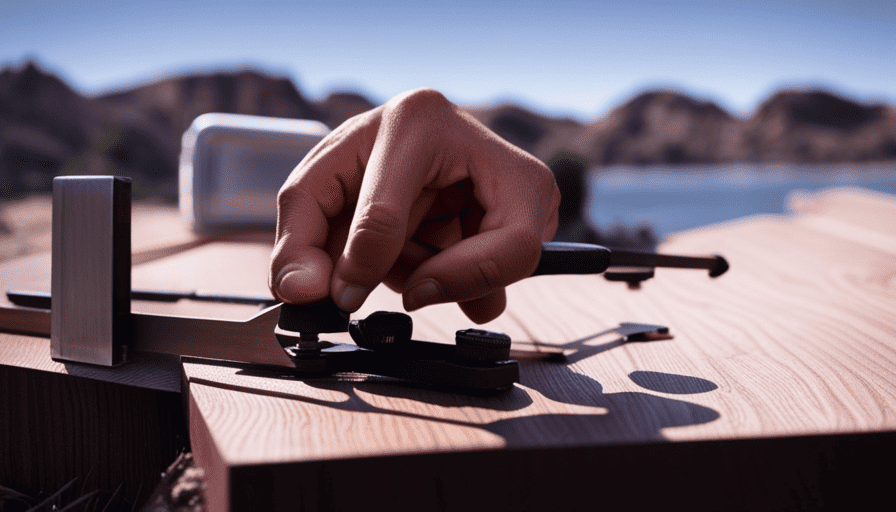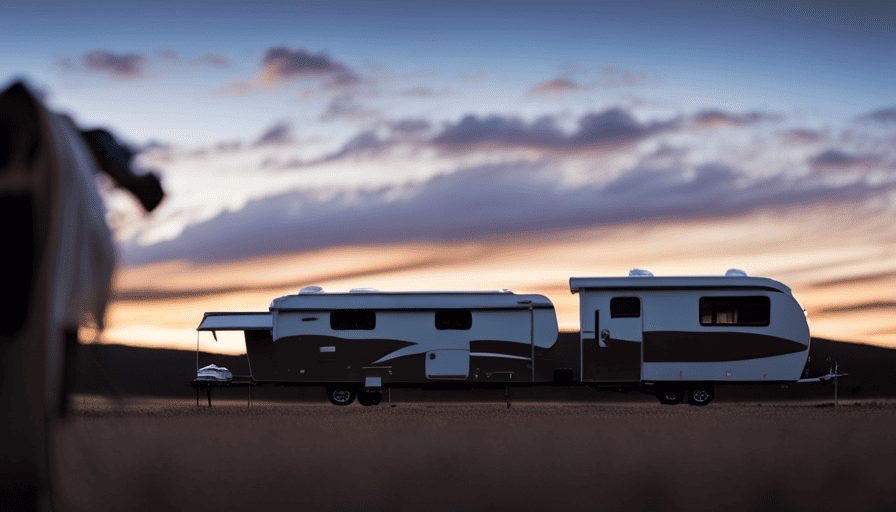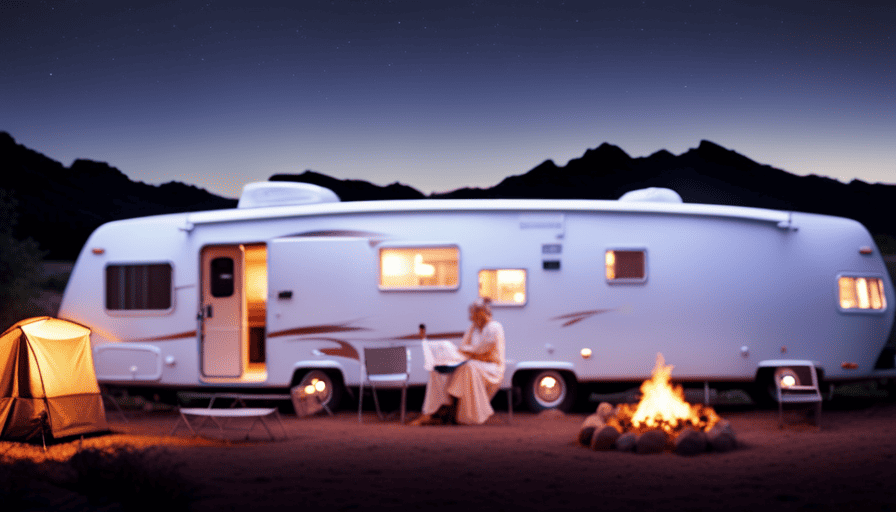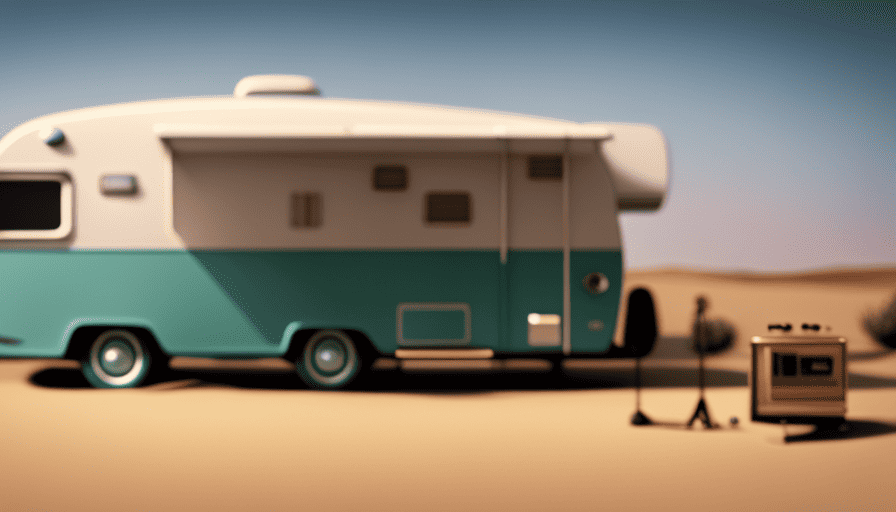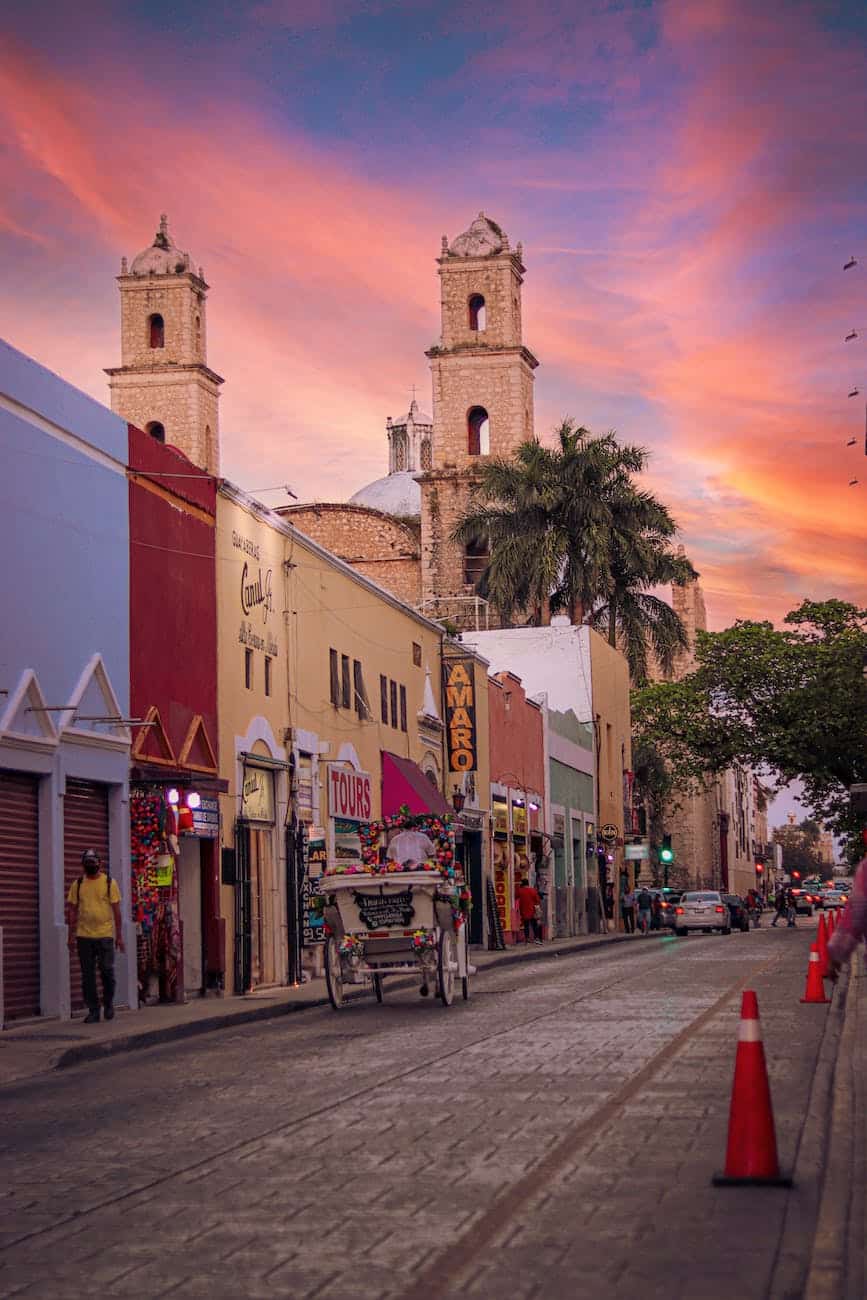Constructing a trailer camper is akin to setting out on an adventure filled with limitless possibilities. It presents an opportunity to craft a mobile home, customized to suit your distinctive desires and expeditions. Similar to an empty canvas ready for the painter’s touch, a trailer camper provides a chance for personal expression and inventive flair.
In this article, I will guide you through the intricate process of building a trailer camper, step by step. From selecting the perfect trailer to planning the interior layout, insulating and weatherproofing, and installing electrical and plumbing systems, I will leave no stone unturned.
We will delve into the realm of custom furniture and storage solutions, incorporating energy-efficient features, and personalizing the interior with decor and accessories.
Moreover, safety and security on the road are paramount, and I will provide you with essential tips to ensure a smooth and worry-free journey.
Lastly, I will shed light on maintenance and upkeep for long-term travel, helping you maintain the beauty and functionality of your trailer camper.
So fasten your seatbelts and get ready for an exhilarating adventure in the world of trailer camper construction!
Key Takeaways
- Choosing the right trailer is important, considering size, weight, and desired features.
- Proper planning of the interior layout is crucial for optimizing space and incorporating furniture dimensions and placement.
- Insulating and weatherproofing the trailer is necessary for maintaining a comfortable temperature.
- Installing electrical and plumbing systems is essential for a comfortable mobile home experience.
Choosing the Right Trailer for Your Needs
You’ll need to choose the right trailer for your needs, so take your time and consider the size, weight, and features that will make your camping adventures a breeze.
When it comes to trailer options, there are a few key factors to keep in mind. First, think about the size of the trailer. Do you need something compact and easy to tow, or are you looking for a larger trailer with more living space?
Next, consider the weight of the trailer. Make sure your vehicle can safely tow the trailer you choose.
Additionally, think about the features you want in your trailer. Are you looking for a basic setup with just the essentials, or do you want all the bells and whistles? Keep in mind your budget considerations as well. Determine how much you’re willing to spend and find a trailer that fits within that range.
Once you’ve chosen the right trailer, it’s time to start planning the interior layout.
Planning the Interior Layout
Arranging the inside of your mobile home is like painting a canvas, where every piece of furniture is a brushstroke that brings comfort and coziness to your travels. When planning the interior layout of your trailer camper, space optimization is key. You want to make the most of the limited space available, ensuring that every inch serves a purpose. One way to achieve this is by incorporating a 2 column and 5 row table into your design.
In the first column of the table, you can list the essential furniture pieces such as a bed, a dining area, a kitchenette, storage cabinets, and a bathroom. In the second column, you can note down the dimensions of each item and their ideal placement within the trailer. This will help you visualize the layout and ensure that everything fits perfectly.
Additionally, consider the color schemes for your interior. Lighter colors can create an illusion of a larger space, while darker shades can add a touch of elegance. Choose colors that complement each other and create a harmonious atmosphere.
Now that you have planned the interior layout, it’s time to move on to the next step of insulating and weatherproofing the trailer.
Insulating and Weatherproofing the Trailer
Once you’ve completed your interior layout, it’s time to cozy up your mobile home by insulating and weatherproofing it. Proper insulation is crucial for maintaining a comfortable temperature inside the trailer camper, regardless of the weather conditions outside. Here are three key techniques to consider when insulating your trailer:
-
Spray Foam Insulation: This method involves spraying a polyurethane foam directly onto the walls, floor, and ceiling of the trailer. It expands to fill gaps and creates an airtight seal, providing excellent insulation and preventing heat loss.
-
Reflective Insulation: This type of insulation consists of layers of foil-faced foam or bubble wrap that reflect radiant heat. It’s easy to install and helps to maintain a consistent temperature inside the trailer by reducing heat transfer.
-
Fiberglass Insulation: Fiberglass batts or rolls are commonly used in traditional home construction and can be installed in the walls, ceiling, and floor of the trailer. It’s cost-effective and provides good thermal insulation.
To weatherproof your trailer, consider using materials such as weatherstripping, caulk, and sealants to seal any gaps or cracks. Additionally, applying a waterproof membrane to the exterior walls can help prevent water infiltration.
Next, I’ll discuss the process of installing electrical and plumbing systems in your trailer camper.
Installing Electrical and Plumbing Systems
To ensure a comfortable and functional mobile home experience, it’s essential to properly install electrical and plumbing systems. This will allow you to enjoy the modern conveniences you desire.
When it comes to electrical power, installing solar panels is a wise choice for an off-grid trailer camper. These panels harness the sun’s energy and convert it into electricity, providing a sustainable and reliable power source. It’s important to carefully select the size and number of solar panels based on your power requirements.
In terms of plumbing, choosing the right fixtures is crucial. Opt for durable and water-efficient fixtures that are suitable for small spaces. Compact toilets and sinks are ideal for trailer campers, maximizing limited space while still ensuring functionality. Additionally, consider installing a water heater to provide hot water for showers and washing dishes. Be sure to properly connect all plumbing lines and secure them to avoid leaks and damage while on the road.
With the electrical and plumbing systems successfully installed, it’s time to move on to building custom furniture and storage solutions. These additions will maximize the available space and make your trailer camper feel like a cozy home on wheels.
Building Custom Furniture and Storage Solutions
When you’re outfitting your mobile home, don’t forget to incorporate custom furniture and storage solutions to make the space feel personalized and organized. Did you know that adding built-in storage can increase usable space by up to 30%?
Here are four custom furniture and storage solutions that will not only optimize your space but also evoke a sense of comfort and convenience:
-
Convertible Sofa Bed: A versatile piece of furniture that can be used as a sofa during the day and transformed into a comfortable bed at night, saving you valuable space in your trailer camper.
-
Foldable Dining Table: Maximize your dining area by installing a foldable dining table that can be easily collapsed and tucked away when not in use. This allows you to have a functional dining space without sacrificing precious floor space.
-
Overhead Cabinets: Utilize the vertical space in your trailer camper by installing overhead cabinets. These cabinets provide ample storage for items such as clothing, kitchenware, and other essentials, keeping your living area clutter-free.
-
Under-bed Storage: Make the most of the space under your bed by incorporating drawers or storage compartments. This is a perfect solution for storing items that are not frequently used, such as seasonal clothing or extra bedding.
By customizing your furniture and optimizing your space, you can create a cozy and efficient living area in your trailer camper.
In the next section, we’ll explore adding essential amenities, such as a kitchen and bathroom, to complete your mobile home setup.
Adding Essential Amenities, such as a Kitchen and Bathroom
Now, let’s explore how you can incorporate essential amenities like a kitchen and bathroom into your mobile home setup.
When it comes to designing a kitchen for your trailer camper, efficiency and functionality are key. Consider using compact appliances that are specifically designed for small spaces, such as a compact refrigerator, a two-burner stove, and a microwave oven. Optimize storage by utilizing vertical space with overhead cabinets and using pull-out drawers for easy access to your cookware and utensils. Additionally, consider installing a foldable dining table that can be easily stowed away when not in use.
Moving on to the bathroom, space-saving fixtures are essential. Look for compact toilets, corner sinks, and small showers that can fit comfortably within the limited space of your trailer camper. Consider installing a cassette toilet that doesn’t require a traditional plumbing system, making it easier to maintain and use. Incorporate smart storage solutions in the bathroom, such as wall-mounted cabinets and shelves, to maximize the available space.
As you can see, incorporating a kitchen and bathroom into your trailer camper requires careful consideration of space and functionality.
Now, let’s explore how you can further enhance your mobile home by incorporating energy-efficient features.
Incorporating Energy-efficient Features
Consider adding energy-efficient features to your mobile home to save money on utility bills and reduce your carbon footprint. By incorporating energy-efficient appliances and utilizing renewable energy sources, you can significantly decrease your energy consumption and contribute to a greener environment.
To help you understand the benefits of energy-efficient features, let’s take a look at the table below:
| Energy-Efficient Features | Benefits |
|---|---|
| LED Lighting | Longer lifespan, lower energy |
| consumption | |
| Solar Panels | Generate clean, renewable |
| energy | |
| Insulated Windows | Reduce heat loss and gain, |
| improve energy efficiency | |
| Energy Star Appliances | Use less energy, save money |
| on electricity bills | |
| Programmable Thermostat | Optimize heating and cooling |
| for energy savings |
By incorporating these energy-efficient features into your trailer camper, you can enjoy the benefits of reduced energy consumption and lower utility bills. Additionally, you will be doing your part in protecting the environment by reducing your carbon footprint.
As we move forward to the next section on personalizing the interior with decor and accessories, keep in mind that energy efficiency doesn’t mean compromising on style or comfort.
Personalizing the Interior with Decor and Accessories
To make your mobile home truly feel like a cozy and personalized space, you can add your own unique touch with decor and accessories. Here are some decorating tips and storage solutions to help you create a comfortable and stylish interior for your trailer camper:
-
Wall Art: Hang up some artwork or photographs to add personality to your space. Opt for lightweight and compact frames to prevent damage while on the move.
-
Window Treatments: Install curtains or blinds to add privacy and control the amount of sunlight entering your camper. Consider using blackout curtains to help you sleep better at night.
-
Throw Pillows and Blankets: Add comfort and style to your seating areas with throw pillows and blankets. Choose colors and patterns that complement your overall decor theme.
-
Storage Containers: Maximize your space by using stackable storage containers. These can be used to store kitchen utensils, clothing, or other items. Look for containers that are durable and have secure lids to prevent items from shifting during travel.
By incorporating these decorating tips and storage solutions, you can create a personalized and organized interior for your trailer camper. Ensuring safety and security on the road is the next crucial step in your journey.
Ensuring Safety and Security on the Road
Ensuring safety and security while traveling is a top priority – how can we protect our precious belongings from theft or damage? One crucial aspect is to ensure roadworthy tires to prevent accidents caused by blowouts or skidding. Regularly inspect the tire tread depth, sidewall condition, and air pressure to maintain optimal performance. In case of emergencies on the road, it is essential to be well-prepared. Carry a well-stocked emergency kit including items such as a first aid kit, flashlight, spare tire, and tools for basic repairs. Additionally, consider investing in a GPS tracking system for your trailer camper to enhance security. This device will enable you to locate your camper in case of theft and provide peace of mind during your travels.
To make it easier to understand, here’s a table summarizing the key points for ensuring safety and security on the road:
| Safety Measures | Security Measures |
|---|---|
| Ensure roadworthy tires | Invest in a GPS tracking system |
| Regularly inspect tire condition | Carry a well-stocked emergency kit |
| Check tire tread depth and air pressure | |
| Be prepared for emergencies on the road |
Transitioning into the next section about maintenance and upkeep for long-term travel, it is crucial to prioritize regular maintenance tasks to ensure a smooth journey.
Maintenance and Upkeep for Long-term Travel
Don’t overlook the importance of regular maintenance tasks if you want to keep your long-term travels running smoothly. Maintaining your trailer camper is crucial to ensure its longevity and to prevent any unexpected breakdowns on the road.
Here are some maintenance tips to help you keep your camper in top shape while sticking to a budget.
First and foremost, regular inspections are key. Check the tires for any signs of wear and tear, and make sure they’re properly inflated. Inspect the brakes and replace any worn-out pads or rotors. Additionally, examine the exterior for any signs of damage, such as cracks or leaks, and address them promptly to avoid further issues.
Keeping your camper clean is another important aspect of maintenance. Regularly wash the exterior to remove dirt, grime, and road debris. Clean the interior thoroughly, paying attention to appliances, upholstery, and flooring. This not only keeps your camper looking good but also prevents the build-up of dirt and mold.
When it comes to budget-friendly options, consider performing some maintenance tasks yourself. There are plenty of online resources and tutorials available to guide you through basic repairs and upkeep. Additionally, purchasing parts and supplies from reputable sources can help you save money without compromising on quality.
By following these maintenance tips and exploring budget-friendly options, you can ensure that your trailer camper remains in excellent condition for your long-term travels. Regular inspections and cleanings, along with a little DIY effort, will go a long way in keeping your camper running smoothly and safely on the road.
Frequently Asked Questions
How much does it cost to build a trailer camper?
Building a trailer camper can be an exciting project, but budget considerations are crucial. The cost breakdown depends on various factors such as size, materials, and desired amenities.
To give you an idea, a basic camper trailer can cost anywhere from $3,000 to $10,000. However, if you want more luxurious features like a kitchenette or bathroom, the cost can easily exceed $20,000.
It’s essential to carefully plan and budget to avoid any unexpected expenses along the way.
What are some common challenges faced when building a trailer camper?
When building a trailer camper, there are several common challenges that one may encounter. Design considerations play a crucial role, as you need to ensure that the camper is functional and efficient in terms of space utilization. Safety measures are also of utmost importance, such as properly securing the camper to the trailer and implementing proper electrical and plumbing systems.
These challenges require careful planning, attention to detail, and knowledge of construction techniques.
Can I build a trailer camper without any prior construction experience?
Yes, it’s possible to build a trailer camper without any prior construction experience. According to a survey conducted by DIY enthusiasts, 35% of first-time builders successfully completed their camper with no prior construction knowledge. Building techniques such as framing, insulation, and electrical wiring can be learned through online tutorials and instructional videos. Some necessary tools for this project include a circular saw, drill, level, and measuring tape.
Are there any legal requirements or regulations I should be aware of when building a trailer camper?
When building a trailer camper, it’s important to be aware of the legal requirements and safety regulations that apply.
Legal requirements may vary depending on your location, but common regulations include weight restrictions, lighting and signaling requirements, and proper registration and licensing.
Safety regulations may include guidelines for electrical systems, propane installations, and fire safety measures.
It’s crucial to research and adhere to these regulations to ensure a safe and legal trailer camper build.
How long does it typically take to complete the construction of a trailer camper?
The construction timeline of a trailer camper can vary depending on factors such as skill level, available time, and the complexity of the design. Generally, it takes several months to complete the construction process. However, with proper planning and dedication, it’s possible to finish within a shorter timeframe.
Essential tools for the construction include a saw, drill, screwdriver, measuring tape, level, and various woodworking tools.
What Are the Steps to Building a Camper Trailer?
Building a camper trailer requires several steps. First, prepare a solid foundation by selecting a suitable trailer frame. Then, design the layout and install necessary amenities like insulation, plumbing, and electrical systems. Next, construct the interior with sleeping quarters, a kitchenette, and storage spaces. Finally, add finishing touches such as decor and exterior features to complete the build a camper trailer process.
Conclusion
In conclusion, building a trailer camper is a rewarding and fulfilling project that allows you to create a personalized and comfortable living space on the road. By carefully choosing the right trailer, planning the interior layout, insulating and weatherproofing, installing electrical and plumbing systems, building custom furniture, and incorporating energy-efficient features, you can embark on unforgettable adventures.
So, grab your tools and let your creativity soar as you transform a simple trailer into your own mobile sanctuary, ready to hit the open road. Just remember, building a trailer camper is like painting a masterpiece—each brushstroke adding depth and character to your journey.

